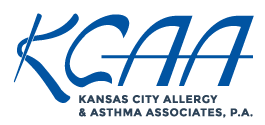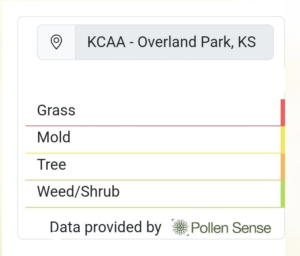Kansas City Allergy Report, Pollen Count & Mold Count
How to Read the Pollen Wise Forecast
For People with Allergies:
0-24: Low, unlikely to experience symptoms
25-49: Medium, some experience mild symptoms
50-74: High, most experience moderate to severe symptoms
75-100: Very high, likely to experience severe symptoms
Breathe easy and seize the day, plan smart and enjoy every moment!
Brought to You Daily by Kansas City Allergy & Asthma
The Pollen Wise Index was designed to help allergy sufferers interpret the effects of pollen levels in their community. The index is categorized into 4 levels: low, medium, high, very high. The index was designed to provide uniformity among the allergen groups: tree, weed/shrub, grass. The categories are separated because they have different thresholds of low, medium, high, and very high.
A pollen count is different from a pollen forecast. Pollen forecasts are projections. Pollen counts, like this data captured at Kansas City Allergy & Asthma, are based on actual counts that reflect the current weather. This is a valuable tool to help people with allergies manage their outdoor activities and take appropriate precautions to manage symptoms. The data can help individuals with allergies make informed decisions about their daily activities.
What is a Pollen Count or Mold Count?
A pollen or mold count is based on the measurement of the number of grains or pollen or mold spores in 1 cubic meter of air. The higher the count, the greater the chance for allergy sufferers to experience symptoms when they are exposed outdoors. The concentration of pollen and mold spores in the air can influence the severity of allergy symptoms experienced by people with seasonal rhinitis, also known as seasonal allergies or hay fever, as well as asthma sufferers. These people can rely on reported pollen and mold spore counts to help plan their days, especially their outdoor activities.
What Impacts Pollen or Mold Levels?
Pollen and mold levels can fluctuate significantly over time. Although seasonal allergens do tend to follow a cyclical pattern, the amount of pollen and mold present in the air can be impacted by the following:
- Region and climate – Colder climates may see a drop in pollen and mold production during the winter while warmer climates may detect airborne allergens year-round. Since weather can fluctuate widely from day to day in Kansas City, it is important to have access to real-time information like the data provided by our Pollen Wise system.
- Season – The severity of pollen in the air fluctuates by season. Tree pollen is usually more severe in the early spring while grass pollen typically causes allergy symptoms in late spring through early summer. Weed pollen can be worse during the late summer and early fall.
- Weather – High temperatures and low humidity cause pollen to travel more. Wind is also a factor, causing airborne pollen and mold to spread more easily.
- Time of day – Different plants release pollen at various times of day, but pollen counts typically are highest in the early morning. Lower pollen counts are generally associated with nighttime, but the levels depend on the type of pollen, e.g., birch pollen can be equal in morning and night.
Managing Pollen and Mold Allergy Symptoms
Pollen and mold in the air causes allergy symptoms such as sneezing, runny nose, nasal congestion, itchy or watery eyes, throat irritation, and wheezing. It can also aggravate asthma among asthma sufferers. The symptoms vary in type and intensity depending on the severity of a person’s seasonal allergies and the concentration of allergen exposure. Symptoms can be reduced by managing exposure to airborne pollen and mold. Better management is possible when checking our real-time Pollen Wise readings during the day.
Plan outdoor activities on days or times when pollen and mold counts are lower. Take these extra steps when pollen counts are high.
- Stay indoors on dry, windy days.
- Avoid lawn mowing, weed pulling, and other garden chores that stir up allergens during high pollen times.
- Remove clothes worn outside and shower to rinse pollen from skin and hair.
- Wear a face mask when doing outside chores during high pollen times.
- Close doors and windows at night if possible or at any other time when pollen counts are high.
- Use AC in the house and car.
- Use high-efficiency filters and follow regular maintenance schedules if using forced air heating or AC.
- Use a portable high-efficiency particulate air (HEPA) filter in the bedroom.
- Clean floors often with a vacuum that has a HEPA filter.
If you are experiencing symptoms – please call our office to schedule an appointment 913-491-5501. Our board certified allergists are here to help you find long term relief to your allergy symptoms.

